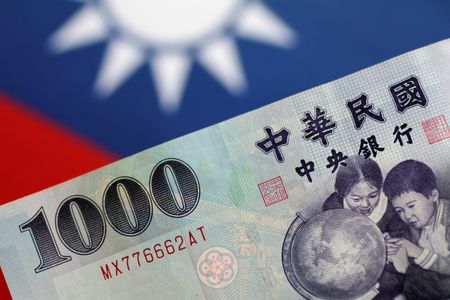By Rishav Chatterjee
(Reuters) – Bullish bets on the Taiwan dollar surged to their highest since late 2020 after the currency posted its steepest one-day gain in nearly four decades last week, as traders wagered Taipei might permit appreciation to smooth trade relations with Washington.
Analysts doubled down on their long positions on the Taiwan dollar and were more bullish on the South Korean won, according to a fortnightly Reuters poll of 11 respondents.
Taiwan’s currency surged more than 6% in just two sessions at the start of May, sparking volatile sessions on the Taipei stock exchange, weakening the U.S. dollar across Asia, and sending shockwaves through global foreign exchange markets.
However, markets speculated that the sharp currency rally was driven by exporters offloading U.S. dollars following a media report that the government might allow the Taiwan dollar to appreciate to secure a more favourable trade deal with the United States.
Francesco Pesole, foreign exchange strategist at ING said local players were seeking greater U.S. dollar hedging as well as starting to diversify away from U.S. investments.
This fits into a more worrying bearish territory for the U.S. dollar, Pesole added.
The dollar index has weakened nearly 7% in 2025 despite gaining over 1% so far in May, fueling investor optimism toward Asian currencies amid speculation about U.S. pressure for stronger exchange rates among trade surplus partners.
On the flipside, analysts had trimmed their bullish bets on the Indian rupee after tensions escalated between India and Pakistan following an attack in Indian Kashmir that killed 26 Hindu tourists.
India and Pakistan subsequently announced a ceasefire over the weekend.
Meanwhile, the world’s two largest economies decided to temporarily lower tariffs for 90 days after talks between Washington and Beijing.
“The recent surge in volatility and the dollar’s recovery following the US’s pause on trade tariffs have cast doubt on the rupee’s appreciation. While short-term weakness in the rupee is likely, its underlying fundamentals remain strong,” said Dilip Parmar, research analyst at HDFC Securities.
Elsewhere, investors were neutral on the Chinese yuan while lowering their long positions on the Malaysian ringgit, the Philippine peso and the Thai baht.
The central banks in the Philippines and Thailand lowered their interest rates by 25 basis points in their latest policy meetings, while the Bank Negara Malaysia held steady.
The Asian currency positioning poll is focused on what analysts and fund managers believe are the current market positions in nine Asian emerging market currencies: the Chinese yuan, South Korean won, Singapore dollar, Indonesian rupiah, Taiwan dollar, Indian rupee, Philippine peso, Malaysian ringgit and the Thai baht.
The poll uses estimates of net long or short positions on a scale of minus 3 to plus 3. A score of plus 3 indicates the market is significantly long U.S. dollars.
The figures include positions held through non-deliverable forwards (NDFs).
The survey findings are provided below (positions in U.S. dollar versus each currency):
DATE USD/CNY USD/KRW USD/SGD USD/IDR USD/TWD USD/INR USD/MYR USD/PHP USD/THB
15-May-25 0 -0.22 -0.54 0.7 -1.01 -0.19 -0.15 -0.68 -0.45
01-May-25 0.20 -0.06 -0.67 1.27 -0.53 -0.58 -0.40 -1.02 -0.61
17-Apr-25 0.57 0.19 -0.26 1.33 0.06 -0.20 0.04 -0.65 -0.30
03-Apr-25 0.47 1.13 0.54 1.20 1.14 0.01 0.33 -0.15 0.40
20-Mar-25 0.24 0.72 0.15 0.97 0.85 1.09 0.42 -0.13 0.08
06-Mar-25 0.77 1.00 0.34 1.36 0.71 1.47 0.45 0.20 0.48
20-Feb-25 0.88 0.83 0.31 1.06 0.59 1.22 0.37 0.31 0.02
06-Feb-25 1.15 1.01 0.86 1.25 1.14 1.98 0.62 0.93 0.23
23-Jan-25 1.33 1.04 1.11 1.50 1.01 1.78 1.01 0.77 0.54
(Reporting by Rishav Chatterjee in Bengaluru; Editing by Eileen Soreng)









